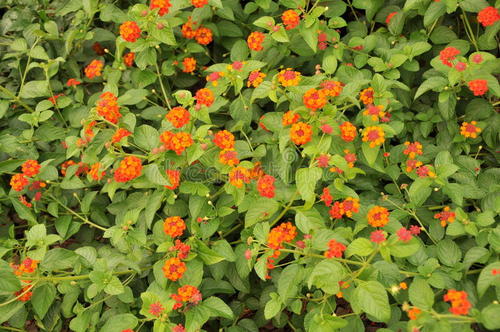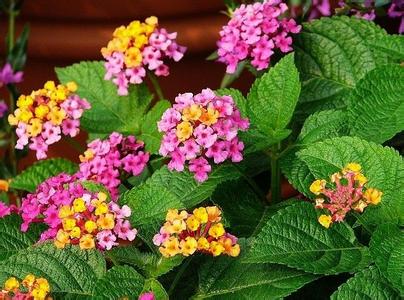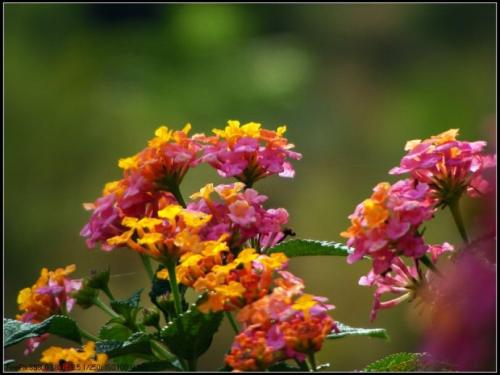Lantana profile
Written by admin
Mar 05 2021

Lantana, also called big-sage, wild-sage, red-sage, white-sage, korsu wiri or korsoe wiwiri, tickberry, West Indian lantana, umbelanterna, the roots, leaves and flowers of Lantana are used for medicinal purposes. Lantana has the effect of clearing away heat and detoxification, dispersing knots and relieving pain, dispelling wind and relieving itching. Lantana can treat malaria, tuberculosis, neck lymphatic tuberculosis, mumps, stomachache, rheumatic bone pain and so on.
Lantana picture

Lantana info
| Botanical Name | Lantana camara |
| Common Names | big-sage, wild-sage, red-sage, white-sage, korsu wiri or korsoe wiwiri, tickberry, West Indian lantana, umbelanterna |
| Plant Type | Perennial in zones 8-11; otherwise annual |
| Light | Full sun |
| Native Areas | Tropical regions of the Americas and Africa |
| Mature Size | 6 feet high and wide (as a perennial) |
| Flower color | Mix of red, orange, yellow, blue, white, pink |
| USDA Zones | 8-11 |
Morphological characteristics of Lantana
Stems
Lantana is an erect or vine shrub, 1 -- 2 m tall, sometimes uniform, up to 4 m long; Stems and branches are square, pubescent, usually have short and barbed spines.
Leaf
Leaves of Lantana are ovate to ovate-oblong, 3-8.5 cm long and 1.5-5 cm wide, apically acute or acuminate, basally cordate or cuneate, margin obtuse, surface coarsely wrinkled and pubescent, back with small bristles, lateral veins about 5 pairs; Petiole is about 1 cm long.
Flowers
Inflorescences of lantara 1.5-2.5 cm in diameter;Pedicels stout, longer than petiole; Bracts are lanceolate, 1-3 times as long as calyx, outer hirsute; Calyx is tubular, membranous, ca. 1.5 mm long, apex with very short teeth; Corolla is yellow or orange-yellow, turning dark red soon after flowering, corolla tubes ca. 1 cm long, with fine short hairs on both sides, 4 -- 6 mm in diameter; Ovary is glabrous.
Lantana lantana blooms all year round.
Fruit
Fruit of lantana lantana globose, ca. 4 mm in diam., purplish black when ripe.
Ecological habits of Lantana
Lantanausually grows on beaches and open areas at an altitude of 80-1500 meters. It likes warm, moist, sunny environment, light, drought resistance, not cold resistance, suitable growth temperature 20-25℃, winter overwintering temperature should not be less than 5℃, in loose, fertile, well drained sandy loam growth is better. Lantana is resistant to pruning, mostly potted north of Yangtze River in China.
The way Lantana propagates
Sow
For small seeds of Lantana that are difficult to clip up with hands or other tools, you can wet one end of the toothpick with water, stick the seeds one by one on the surface of the substrate, cover the substrate 1 cm thick, and then put the seeding pot into the water, the depth of the water is 1/2 ~ 2/3 of the height of the pot, and let the water slowly soak up
Cuttings
Lantana cutting propagation is often in late spring and early autumn with the branches of the year for tender cuttings, or in early spring with the branches of a year old cuttings.
How to grow and care for Lantana
1. Humidity care
Lantana likes wet or semi-dry climate environments. It requires the relative temperature of air in the growth environment to be between 50 and 70%. If the relative humidity of air is too low, the lower leaves will turn yellow and fall off, and the upper leaves will be dull.
2. Temperature care
Because Lantana is native to the subtropical region, it is very strict in winter temperature, and stops growing when the ambient temperature is below 8 ° C.
3. Lighting care
The light adaptation ability is strong. Put in indoor maintenance, put in the place that has bright light as far as possible, wait for a place like the sitting room with good daylighting, bedroom, study. After indoor maintenance for a period of time (a month or so), it is necessary to move Lantana to the outdoor shade (winter heat preservation conditions) of the place for maintenance for a period of time (a month or so), so alternate.
4. Fertilizer and water care
For Lantana potted plants, in addition to adding organic fertilizer to the pot, during the normal curing process, it is necessary to carry out proper fertilizer and water management.
5. Spring, summer and autumn care
These three seasons are the peak season for its growth. The fertilizer and water management cycle is in the order of "Huabao" → "Huabao" → "Huabao" → "Huabao" → "Qingshui". The interval period is about 1-4 days.
6. Winter care
In the winter dormant period, it is mainly to do a good job of controlling fertilizer and water. For Lantana planted in the ground, according to the drought in spring and summer, apply 2 ~ 4 times of fertilizer water: first in the root neck outside 30 ~ 00 cm to open a circle of small groove (the bigger the plant, the farther from the root neck), groove width and depth are 20 cm.Sprinkle 25 ~ 50 jin of organic fertilizer, or 1 ~ 5 two particles of compound fertilizer (chemical fertilizer) into the ditch, and then pour on permeable water. After winter and before spring, apply fertilizer again according to the above method, but do not water.

7. Pruning care
Lantana plants are dormant or semi-dormant in winter. Cut off weak, diseased, dead, or overcrowded branches. It can also be combined with cuttings to finish the branches.
8. Basin care
As long as it is properly maintained, Lantana will grow very fast. When it reaches a certain size, it is necessary to consider changing it to a larger pot so that it can continue to grow vigorously. The culture soil and the proportion of the components can be used for changing the pot: garden soil: slag = 3:1; Or garden soil: medium river sand: sawdust = 4:1:2; Or paddy soil, pond mud, leaf rot soil in one of the. Take off the pot: put the flowers to be changed on the ground, and pat them around the pot with your palm first, so that the root system will be shaken and separated from the wall of the pot, and put the pot upside down on the left
On the hand, the index finger and middle finger of the left hand gently clamp the plant, the wrist and fingertip against the edge of the basin, the right hand pat the bottom of the basin, and then use the mother finger to push the root soil down from the bottom hole to the top, let the plant out.When removed, pat the soil gently with your palms to remove excess soil.
9. Prepare flower pots
Choose a flowerpot of appropriate size, the bottom hole of the basin is covered with two tiles or thin foam pieces, to ensure that the soil is not washed out by water, but also to make the excess water flow out in time. A layer of ceramsite or broken red brick is placed on top of the tile or foam to act as a filter layer, about 2 to 3 cm thick. Drainage layer and then put a fertilizer machine fertilizer, about 1 ~ 3 cm thick, fertilizer on a thin layer of substrate, about 2 cm thick, in order to separate the root system and fertilizer, finally put the plants in, fill nutrient soil, from the mouth about 2 ~ 3 cm can be left.
Lantana uses
Ornamental value
Lantana lantana is an ornamental plant with a long flowering period and can blossom throughout the year. It is an ideal ground cover plant for flower observation, and the most suitable period is from late spring to autumn. Lantana lantana flowers are small, but most of them gather together, like colored pom poms inlaid or interspersed with green leaves. They are beautiful and colorful, and each flower can change a variety of colors from bud stage to flower drop stage. Lantana can enrich the landscape, there is a lively sense of beauty.
In addition, there are the corolla yellow lantana, corolla orange-red or orange-yellow orange-red lantana, corolla pink pink lantana, corolla creamy yellow lantana and many other cultivated species. It can be planted in the streets, carriageways and flower beds, adding color to the city streetscape. You can also do flower hedge on both sides of the garden road, hill afforestation, or do potted decoration for viewing.It can also be used as background material, or planted in flower beds, corners and wall bases with ribbons, rings and irregular shapes to ornament, decorate and cover.
Green value
Lantana with fertility strong, fast growth, wide adaptability, don't choose the soil, high temperature resistant, drought resistance, fewer pests, root developed, bark germination power, the crown cover a big advantages, can not only single, spread, but also and other trees, shrubs, herbs, mixed, flush the surface to reduce the wind rain, solid intercepting soil and water conservation, improve soil, increase fertility, improve the ecological environment effect is obvious, therefore, is of greenland, barren hills, grassland, highly-efficient water-powered device, valley, slope, especially to protect the camp, slope protection, good shrub tree species of dike dam.
Lantana economic value
In industry, the root of Lantana delavana contains rubber analogues, which can be used to make rubber, and the stem is a raw material for paper making. The leaves can be added to tobacco to add flavor and can also be used for polishing instead of sandpaper.Although the content of essential oil extracted from the stem, bark, leaves and flowers of Lantana is lower (0.15%), it is similar to peppermint oil, has a good fragrance, and has the activity similar to juvenile hormone. Imigran biomass released from the seeds and leaves of Lantana can be used to produce biological herbicide. Leaves have insecticidal effects and can be used to make biocides.
Varieties of Lantana
Trailing Lantanas (L. montevidensis): These have longer branches (up to 12 inches long) and are popular for baskets or hanging displays.
Popcorn lantana (Lantana trifolia): This type is known for its relatively small and bright clusters of flowers.
Wild lantana (Lantana horrida): Found in Texas, these have especially pungent leaves.
'Spreading Sunset' (Lantana x 'Monet'): This cultivar has a flower head with gold centers surrounded by orange. This orange color later fades to pink
Toxicity of Lantana
While lovely to look at, growing Lantana in your landscaping has its problems. Besides being invasive in warm climates, lantana plants are toxic and present a danger to children and pets. The leaves can cause a rash and eating the unripe berries can be fatal.

Latest Updated
- Benefits of Bugleweed - 7 Science-backed Health Benefits
- Bugleweed Dangers & Side Effects - Is It Poisonous?
- How to Plant Evergreen Trees - What You Should Know
- When to Plant Evergreens - Grow Guide for Evergreen Trees
- 12 Wonderful Evergreen Shrubs for Your Garden
- 12 Popular Evergreen Plants with Pictures for Beginners
- When And How To Prune A Lilac Bush Like a Pro
- How to Grow & Care for Lilac Vine (Hardenbergia Violacea)
- Japanese Lilac Tree (Syringa Reticulata) Care & Propagation Guide
- Shumard Oak Pros and Cons - What to Know
Popular Articles
- Winter maintenance of Antirrhinum Majus
- How to Grow Terminalia Mantaly Tree
- How to Grow and Care for Crossostephium Chinense
- How to grow Antirrhinum Majus in spring
- Peristeria Elata (Dove Orchid) Profile: Info & Care Guide
- Underwatered Snake Plant (Sansevieria Trifasciata) - Signs And How To Fix
- How to Care for Brazilian Jasmine Plant (Mandevilla Sanderi)
- How to Grow & Care for Graptopetalum Purple Delight in Summer
- Rosa Chinensis (China Rose): Plant Growing & Care Tips
- How to Care for Baby Sun Rose (Aptenia Cordifolia)